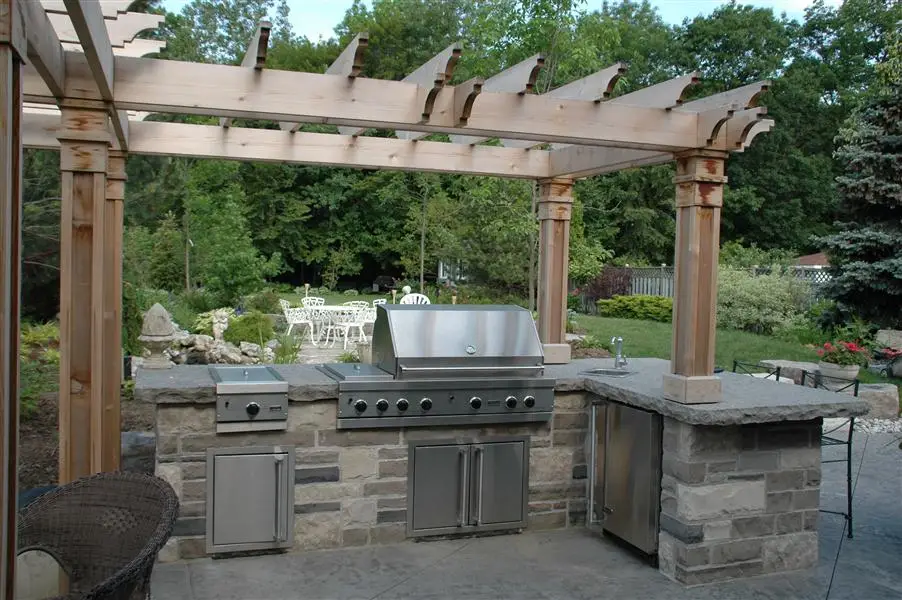Constructing an outdoor kitchen involves careful planning, design, and execution to create a functional, durable, and aesthetically pleasing space for cooking, dining, and entertaining outdoors. Here are the key steps involved in outdoor kitchen construction:
- Design and Planning:
- Start by defining your goals, preferences, and budget for the outdoor kitchen project. Consider factors such as the size of the space, layout, desired features, cooking appliances, seating areas, and materials.
- Work with a professional designer or contractor to create a detailed design plan that includes the layout, dimensions, materials, appliances, fixtures, lighting, and electrical or plumbing requirements.
- Obtain any necessary permits or approvals from local authorities before starting construction.
- Site Preparation:
- Prepare the site for construction by clearing the area of vegetation, debris, and obstacles. Level the ground and ensure proper drainage to prevent water pooling or flooding in the outdoor kitchen area.
- Determine the location of utilities such as water, gas, and electricity and plan the layout accordingly. Install any necessary utility lines or connections before proceeding with construction.
- Foundation and Base Construction:
- Build a sturdy foundation or base for the outdoor kitchen structure. Depending on the design and location, this may involve pouring a concrete slab, constructing a raised deck or platform, or laying pavers or tiles.
- Install a waterproof membrane or vapor barrier beneath the flooring to protect against moisture damage and ensure longevity.
- Framework and Structure:
- Construct the framework and structure of the outdoor kitchen using durable materials such as treated lumber, steel, or aluminum. Build support frames for countertops, cabinets, and appliances, ensuring they are level, plumb, and securely anchored.
- Install any additional features such as walls, partitions, pergolas, or roof structures to provide shelter, shade, and privacy as desired.
- Installation of Appliances and Fixtures:
- Install the necessary plumbing, gas lines, and electrical wiring for outdoor kitchen appliances and fixtures. Work with licensed professionals to ensure compliance with building codes and safety standards.
- Position and install cooking appliances such as grills, smokers, pizza ovens, cooktops, and outdoor ranges according to the design plan. Install other fixtures such as sinks, faucets, refrigerators, ice makers, and storage cabinets as needed.
- Countertops and Surfaces:
- Choose and install durable countertops and surfaces for the outdoor kitchen that can withstand exposure to the elements, heat, and moisture. Options include natural stone (granite, marble, quartzite), concrete, tile, stainless steel, or outdoor-rated wood.
- Seal or finish the countertops to protect against stains, scratches, and weathering, and ensure easy cleaning and maintenance.
- Finishing Touches:
- Add finishing touches to the outdoor kitchen to enhance its functionality, comfort, and aesthetics. This may include installing lighting fixtures, outdoor fans, heaters, sound systems, and entertainment features.
- Furnish the outdoor kitchen with comfortable seating, dining furniture, and accessories such as rugs, cushions, and decor to create a welcoming and inviting outdoor living space.
- Final Inspection and Testing:
- Once construction is complete, conduct a final inspection of the outdoor kitchen to ensure that all components are installed correctly, and systems are functioning properly.
- Test the operation of appliances, fixtures, utilities, and safety features to verify compliance with building codes and regulations.
- Maintenance and Care:
- Establish a regular maintenance routine to keep the outdoor kitchen clean, well-maintained, and in good condition. Clean surfaces, appliances, and fixtures regularly, and inspect for signs of wear, damage, or deterioration.
- Protect outdoor kitchen components from harsh weather conditions, UV exposure, and seasonal changes by covering or sheltering them as needed. Perform any necessary repairs or replacements promptly to prolong the lifespan of the outdoor kitchen.
By following these steps and working with experienced professionals, you can create a well-designed and functional outdoor kitchen that enhances your outdoor living experience and adds value to your home.
